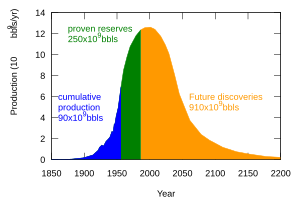M. King Hubbert facts for kids
Quick facts for kids
M. King Hubbert
|
|
|---|---|
 |
|
| Born |
Marion King Hubbert
October 5, 1903 San Saba, Texas, U.S.
|
| Died | October 11, 1989 (aged 86) Bethesda, Maryland, U.S.
|
| Nationality | American |
| Occupation | Geologist, geophysicist |
| Known for | Hubbert peak theory |
| Awards | Penrose Medal (1973) Vetlesen Prize (1981) Elliott Cresson Medal (1981) |
Marion King Hubbert (born October 5, 1903 – died October 11, 1989) was an American scientist. He was a geologist and a geophysicist. He worked at the Shell research lab in Houston, Texas.
Hubbert made many important discoveries in geology and geophysics. He is best known for his ideas about how we use natural resources. His most famous ideas are the Hubbert curve and the Hubbert peak theory. These ideas help us understand when the production of oil and gas might reach its highest point. People often called him "M. King Hubbert" or "King Hubbert."
Contents
Biography
Hubbert was born in San Saba, Texas. He went to the University of Chicago. There, he studied geology, mathematics, and physics. He earned three degrees from the university.
While studying, he also worked as a geologist for a company called Amerada Petroleum. He taught geophysics at Columbia University. In 1943, he joined the Shell Oil Company. He worked there until he retired in 1964. After leaving Shell, he became a senior researcher for the United States Geological Survey. He worked there until 1976. He also taught at Stanford University and the UC Berkeley.
Hubbert was interested in a movement called Technocracy. He helped start an organization called Technocracy Incorporated. He wrote a study guide that suggested a different way to manage the economy. Instead of using money, he thought we could use "energy accounting." This means tracking how much energy we use for everything.
Hubbert passed away on October 11, 1989, when he was 86 years old.
Research and Discoveries
Hubbert made several important discoveries in geophysics. He showed that rock deep inside the Earth's crust can bend and change shape. This happens because of the huge pressure it is under. This idea helped explain why the Earth's crust moves and changes over time. He also studied how liquids like water and oil move underground.
Hubbert's Peak Theory
Hubbert is most famous for his studies on oil and natural gas. He looked at how much oil and gas we have and how fast we produce it. He predicted that for any area that produces oil, like a country or the whole planet, the rate of petroleum production would follow a bell curve. This means production would start low, rise to a peak, and then decline.
In 1956, he shared his theory at a meeting in Texas. He predicted that oil production in the United States would reach its highest point between 1965 and 1970. Many people did not believe him at first. Other predictions about oil had been wrong before.
However, Hubbert became famous when U.S. oil production peaked in 1970. It then started to go down, just as he had predicted.
In 1974, Hubbert also predicted that global oil production would peak around 1995. This was "if current trends continue." Since then, many others have made predictions as trends have changed.
Hubbert believed that solar power could be a good replacement for fossil fuels. He also thought that nuclear energy could provide power for hundreds of years. He felt that if the world's population could be controlled, we would have enough energy for a long time.
Key Contributions
Here are some of Hubbert's main contributions to science:
- He showed that rock in the Earth's crust can act like plastic. This means it can deform and change shape over time.
- He predicted how hydrocarbons (like oil and gas) move underground.
- He predicted when oil and gas production would reach its highest point. He used a math model that connected how much oil was discovered, how much was available, and how fast it was produced. His model is still very important today. It has been used for many other limited resources.
Renewable Resources and the Hubbert Curve
The Hubbert curve can also help us understand other resources. For example, some researchers have used it to study the whaling industry. They looked at how the number of whales caught changed over time.
Another example is the Atlantic northwest cod fishery. This was a renewable resource, meaning the fish could reproduce. However, too many fish were caught. The number of fish taken was more than the fish could replace. The end of the cod fishery followed a pattern similar to the Hubbert curve. This shows that human activity can cause many resources to go through a cycle of depletion.
Awards and Honors
Hubbert was a member of important science groups. These included the National Academy of Sciences. He was also part of the American Academy of Arts and Sciences.
He was involved with the Geological Society of America for a long time. He received the Arthur L. Day Medal in 1954. He was elected President of the Society in 1962. In 1973, he received the Society's Penrose Medal. He also received the Vetlesen Prize and the Elliott Cresson Medal in 1981.
See also
 In Spanish: M. King Hubbert para niños
In Spanish: M. King Hubbert para niños
- Bioeconomics (biology)
- Fred Meissner
- The Limits to Growth


